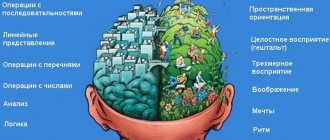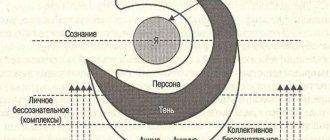Definition of what archetypes are
Archetype translated from Greek means prototype, original, original. Currently, in psychoanalysis, an archetype is understood as part of the collective unconscious in a person. This is a “dark” piece of personality that indirectly affects her life.
This is a not very clear definition. Let's now figure out, so to speak, on the fingers, what kind of part this is in each of us.
Carl Gustav Jung was an outstanding student of Sigmund Freud, but he left his teacher and created a unique school - analytical psychology. It was he who first used the concept of archetype.
According to Jung, this concept means that we have a certain shadow from our ancestors and when we find ourselves in some unfamiliar situation, by inertia we act as our ancestors would have acted. This is the influence of the collective unconscious on our lives. There were also Jung's followers who complemented his theory about personality structure. But the classic version is precisely his theory.
I will not go into complex psychological concepts. Let me give you an example.
The river flowed, then for some reason it dried up, but the bottom remained with the same mounds, depressions, and stones. And when, after a few years, new sources open and water begins to flow along the bottom of a dry river, streams of water flow in the same way as the previous ones, stumbling over stones, quickly flowing through hollows. This is the “shadow” of the river.
So it is with archetypes. There are those that influence us, whether we like it or not, for example, Anima and Animus, Self, Shadow, Persona. The influence of other archetypes depends on the scenario of a person’s life, for example, there are the archetypes “Wise Old Man”, “Mother”, “Jester”, etc.
There are other typologies of human personality, but we will talk specifically about the theories of Jung and Pearson-Marr.
Psychological subtype God
The archetypal concept was continued to be developed by Shinoda Bohlen. She studied female and male archetypes in such a science as mythology. The scientist identified the following subtypes:
- Zeus is a strong-willed and self-confident type.
- Hades is an aloof, quiet and mysterious subtype.
- Apollo is a mature and rational person who acts using common sense.
- Hephaestus is a hardworking and strong personality.
- Dionysus is an enthusiastic and non-conflict subtype.
As for female gods, the scientist singled out the strong and risky “Artemis”. "Athena" is wise and strong-willed. If necessary, she is able to discard emotions and analyze the available facts.
"Aphrodite" is a sensual and gentle person. “Tufé” is considered a contradictory person , striving to embrace the immensity. This subtype may be hindered by the inability to foresee the consequences of the actions taken.
The Hecate type is considered a great mystifier. People belonging to this type are prone to studying occult practices.
Each individual combines several competing archetypes. They control the medium, influencing the definition of areas of interest and direction of activity.
Personality structure of C. G. Jung
The theory of archetypes is not difficult to understand; the main thing is to understand what the author wanted to tell us about personality.
Personality archetypes according to Jung
At the top of the structure we see the word “Ego”, sometimes replaced by the simple “I”. This is human consciousness, what we are aware of specifically at this moment. Namely: feelings (I’m hungry), thoughts (Lenka is a traitor, she could have warned), memories (what a great summer it was, so much communication and travel!).
Next to “Ego” is “Persona”. Our consciousness has discarded not very important experiences here as unnecessary. For example, I’m worried that my sister is sick, but now what’s more important to me is that I’m hungry. “Ego” and “Persona” are connected. A person, when necessary, can easily extract data from his “Persona”. Also, a person’s image, his social image, depends on this archetype.
Then we move on to the middle layer. “Shadow” meets us there. It is here that we accumulate grievances, fears, experiences that our psyche, caring for us, has repressed. Everything that contradicts our current ideals, attitudes, everything that our “I” and “Persona” cannot bear is stored here. Our complexes are also stored here.
After this layer come “Anima” and “Animus”. So we come to the collective unconscious - these are the very archetypes that we are talking about. Our ideas about men and women, ideal life, social roles, etc. are stored here.
The last archetype is the “Self”. The author considers it the most important, the most harmonious, complete, and comprehensive. It is characterized by self-sufficiency and integrity. This is the core of personality. It is very rare and is expressed weakly in personality. But everyone should strive to develop it, as this will lead a person to self-love and complete harmony.
This “unpacking” of personality according to Jung’s archetypes allows psychotherapists to qualitatively change the lives of clients step by step, carefully making their way to attitudes that have been instilled over the years, generations, which can provoke dissatisfaction in current relationships and the search for non-existent ideals.
So, according to Jung, the archetypes are:
- sustainable;
- always cause a human reaction;
- found in all nations at different times;
- influence the emotional state;
- may have positive and negative characteristics;
- reflected in fairy tales and myths.
Shadow
The shadow is what you least want to see in yourself; that which obscures itself. But there is no way to get closer to the “I”, so a collision with the shadow on the way to the true “I” is inevitable. This archetypal figure took the form of various personifications among primitive peoples. They considered it a bad omen if someone stepped on a physical shadow; the damage received can only be restored with the help of a special magic ritual. In addition, the figure of the shadow has often been used in art. The artist most actively draws from the unconscious, with his creations he sets in motion the subconscious of readers, viewers, listeners, and this is the main secret of his influence on people. Having awakened in him the images and figures of the unconscious, they also capture other people who, of course, do not know the source of their “capture”.
The development of the shadow goes hand in hand with the development of the “I”: qualities that the “I” does not need or cannot use are put aside or suppressed, thereby losing their role in the conscious life of a person. Therefore, the child essentially has no shadow.
The shadow can find its manifestation both in the symbolic figure of the inner world and in the outer world. In the first case, it manifests itself through dream figures that embody certain mental characteristics of the individual. In the second case, we project one or another of our latent, unconscious qualities onto a representative of our environment, who, due to certain characteristics, is best suited for this. But the easiest way to notice the “shadow” qualities in yourself is to recognize that they are part of our nature. This happens, for example, when we are overcome by fits of rage, when we suddenly begin to swear or act arrogantly, when we commit socially unacceptable acts against our will, when we are petty, sneaky, cowardly, cowardly, impersonal or hypocritical, thus exhibiting qualities which under normal circumstances would be hidden within us or so thoroughly suppressed that we are not even aware of their existence. When such qualities are brought to the surface so clearly that they can no longer be ignored, we ask the question: “How is this possible? Is it really just me?
Paradoxical as it may seem at first glance, the shadow in the form of an alter ego can also be presented as a positive figure. This reversal occurs when a person lives “below his level” and does not fully develop his abilities. In such cases, it is the positive qualities that lead to dark “shadow” existences. They can be identified in ourselves in the same way as the dark side of the shadow: It is the qualities and manifestations that make up our shadow that most irritate and delight us in others.
Jung distinguished between personal and collective forms of the shadow. The first contains those spiritual qualities of a person that did not manifest themselves in him at all or manifested themselves to a very limited extent in his early childhood. The second belongs to the figures of the collective unconscious and symbolizes the “other side” of the dominant Zeitzgeism, its hidden antithesis. Both forms of shadow play a significant role in a person's state of mind.
Pearson-Marr archetypes
The theory of archetypes and their influence on human life was improved by K. Pearson and H. Marr. These researchers of the secrets of the human soul combined the classical theory of Jung with the theory of basic social motives of D. McClelland, H. Heckhausen and the theory of basic human needs of A. Maslow.
The result is a very interesting theory about 12 personality archetypes, which is successfully used in branding and trading. Let's take a closer look at what it is. The descriptions of these archetypes are quite interesting.
12 Personality Archetypes
Seeker
He tries to understand and know everything in this world, to find himself, to realize everything that is inherent in him. The seeker is constantly “on the crest of a wave.” He strives for a bright, full life, achieving new heights. Its main characteristics:
- ambition;
- independence;
- honesty with yourself and others;
- activity;
- indigestion of boredom and monotony;
- ability to take risks.
Among the celebrities, the following “Seekers” are known: Evgeny Bazhenov, Leonid Parfenov, Nikolai Fomenko.
Simple-minded
Sometimes called “innocent”, “child”. Such a person naively believes that in an ideal world everyone should be “themselves” and not be responsible for it. He delays making decisions, hoping that everything will “resolve.” He believes in the best and thinks that he will be able to idealize his life. Main characteristics:
- inspires confidence and optimism;
- cheerful;
- sincerely wants to become happy;
- trusting and defenseless;
- the desire to give joy to others, to please them;
- increased fear of making a mistake and being punished.
The “simple-minded” are hiding among celebrities. But one of the heroes of the films can be called the Associate Professor - a simple teacher from a kindergarten. Lyudmila from “Queen of the Gas Station” and some others.
Sage
He is a thinker and philosopher. His main task in life is to understand the truth. All his actions are aimed at becoming an expert, learning what is important in this world. Has high intelligence. He is frightened by his own errors in judgment, afraid of being deceived in his expectations. He is attracted more by theory than by practice - a lot of thoughts, but few actions. Main characteristics:
- knows how to think critically;
- relies on knowledge, intelligence;
- can study all his life without ever starting to act;
- knows how to accurately formulate his opinion.
This archetype was characteristic of Socrates, Galileo, and Buddha.
Hero
This is truly a Warrior and a Winner. His whole life is spent proving to the world that he is competent, significant, strong and has power. He is inclined to choose the most difficult paths, has fearlessness and enviable willpower. He uses all this to help others. He is afraid if they call him a coward, he does not want to show his weakness and vulnerability. Prone to arrogance, cannot stop.
Characteristics:
- brave;
- hard;
- purposeful;
- disciplined;
- defender;
- decisive and persistent;
- tends to divide the world only into black and white;
- boastfulness appears.
This archetypal image is often found in films, and in life, such people are visible, as they are always ready to protect the weak. The following heroes are known: James Bond, Batman, etc.
Mage
This is a charismatic leader, healer, mediator. He knows how the world works, tries to develop science, his vision and implement it into practice. But sometimes he manifests “woe from his mind” - he becomes a manipulator. Examples of such personalities are politicians with charisma, business leaders, for example, Bill Gates. They have a powerful influence on human consciousness and behavior.
Main characteristics:
- charm and charisma;
- catalyst for change;
- knows how to find a way out even where there cannot be one;
- learns everything down to the smallest detail in order to get to the bottom of the truth.
Rebel
He is recognized as a revolutionary, a wild woman or a man. This is a person unadapted to life according to the rules. It is important for him to destroy what does not work. But he is subconsciously afraid of being powerless or inconsistent. It can be characterized:
- strives to break everything that is not beneficial to him or someone else (this is where new reforms come from, whether they are useful or not, but the main thing is to break);
- strives for radical freedom;
- the constant spirit of revolution;
- has a desire to shock others;
- can act in seemingly hopeless situations;
- knows how not to grieve for the past, but to let go and start new.
You can name the main revolutionaries and get to the point: Robin Hood, Zorro, Joan of Arc, Martin Luther and others lived with this archetype.
The next three archetypes are distinguished based on the need for belonging and love, as well as the social motive in affiliation (helping others).
Lover
The main goal of such people is to achieve sensual pleasure. In any relationship, they strive to make experiences, work and surroundings pleasant. The worst thing for them is to be left alone, to become unloved. But this type is dangerous because by “throwing himself at the feet” of others, such a person risks losing his individuality.
Main characteristics:
- thirst for emotions, pleasures;
- romantic nature;
- strives to love and receive love;
- such people are more frivolous, they rely on the external rather than on the content of a person, his worldview and values.
A striking example from myth is the ancient Greek Alcyone - she threw herself into the sea out of great love for her husband. It seems that we meet Marilyn Monroe with this archetype. Now many modern singers rely on this archetype, whether they are one or not. This is what evokes emotion, a sense of aesthetics, which is why sexuality and sensuality makes them popular.
Nice fellow
This is an absolutely simple, “average” person, a realist, a hard worker who performs his duties well, maintains communication with a desire and achieves everything himself, regardless of whether he succeeds or not. Such people are characterized by:
- non-acceptance of arrogance on the part of others;
- perceives everyone equally, can laugh at himself when necessary;
- good citizen;
- he has no pretense, he is straightforward;
- reliable;
- predictable;
- wants to be accepted by society, therefore will protect this society;
- but does not believe that something good can come on its own;
- looks like an orphaned child who needs to dig the ground for happiness.
This archetype is well expressed in the role of Semyon Semenovich Gorbunkov in the film “The Diamond Arm”.
Jester
This is the soul of the company, thanks to which society is always funny, cheerful and interesting. For the sake of fun, he can constantly laugh at others, turning absolutely everything into a joke. Such people charge others with their fun, but risk wasting their lives in this fun. They are characterized by:
- the desire to live in the present moment, enjoy it and not think about the consequences;
- frivolity;
- the desire to bring more brightness and humor into the world;
- impulsiveness and spontaneity.
The most prominent representative of this archetype at all times is Charlie Chaplin. But after reading his letter to my eldest daughter, I understood the depth of this personality.
And the last triad of human archetypes is based on the need for security and motivation for power.
Caring
This is the image of a selfless nurse, an honest policeman, a sacrificial teacher. Such people are in a hurry to bestow their care on everyone, but whether anyone needs it or not is no longer important. They tend to:
- help others selflessly;
- empathize;
- show generosity and nobility;
- demonstrate the ability to make various sacrifices for other people;
- may fall into the trap of others taking advantage of their kindness and compassion;
- sometimes they impose their care even when the other person has no need for it.
Among famous people, the “caring” one can be seen in Mother Teresa, Princess Diana, and also the prototype of this archetype is in ancient Greek mythology - the fertility goddess Demeter.
Creator
It can be seen in famous musicians, artists, dreamers. They are the engines of beauty on earth. Their desire is to create eternal values through the centuries, they transform their creativity in thinking into reality, giving others aesthetic pleasure. They can be broken by the eternal desire for perfection; without achieving it, they risk falling into depression and engaging in false creativity.
Their characteristics:
- experimenters, innovators in their field;
- ambitious, artistic;
- rich imagination;
- do not tolerate a mediocre attitude to work, mediocrity;
- dreamers dream of creating something valuable and eternal.
Among famous personalities we can remember Thomas Edison, Pablo Picasso, Ludwig van Beethoven.
Ruler
The name speaks for itself. These are politicians, leaders, responsible citizens. Their goal is to control everything and everyone. They are afraid of chaos, of losing control over something and their place in power. They are attracted by status, prestige and wealth. Characteristic:
- strive for leadership positions;
- seek to gain power and control;
- know how to take responsibility;
- correspond only to their own values;
- wish to create a successful society, family, state;
- they dislike those who violate order and their canons.
Famous “rulers” were Nero (but he had a shadow side - a tyrant ruler), Margaret Thatcher, Winston Churchill, Joseph Stalin and others.
These are 12 main personality archetypes, on the basis of which brands and advertising campaigns are created to promote various products. More on this below.
Knowing your archetype, you can calm down, for example, that you don’t need to achieve any heights, as others demand, or you can create something of your own and devote time to it. This will help you find purpose in life.
Anima
Anima is actually an archetype of women, that is, the unconscious area of the female personality, the image that is transmitted to the girl from her roots and absorbed into her subconscious. This image has a huge influence on a woman’s fate; it defines her behavior scenarios, social type and character model.
The archetypal psychology of a woman is based on her nature, a set of psycho-emotional qualities, reactions, instincts, rules and beliefs that were not the result of life experience.
Amazon
An Amazon is a woman who will never become a housewife. Active, independent, militant and courageous, she knows what she wants from life, and she goes for it herself. He doesn’t ask for anything, doesn’t forgive mistakes, isn’t afraid of failures.
Such a woman is always at the top, she is the best in any team, but she is not used to “grazing the rear.”
She can be rude, sarcastic, sarcastic, but she always gets her way. The Amazon manages to do everything: take care of herself, develop as a person and build a career, and also relax in style.
She does not strive to get married; children and family often cause her despondency rather than inspiration.
Geisha
A geisha (or hetera) is a beautiful woman who is admired by people around her, and they say about her that she is a “breed”.
Refined, refined, with innate excellent taste, Geisha loves and knows how to enjoy life.
Does not like to get attached and be dependent or controlled, strives for independence. This woman knows how to achieve her goal, but rarely sets big goals - she mainly strives for comfort, luxury and a beautiful life, but with age her course may change.
Woman Sorceress
The Witch (or Priestess) woman is a person whose archetypal psychology is very deep and complex.
It seems that this lady knows everything about everyone and sees the whole world through and through.
She knows how to penetrate someone else's consciousness and find out all the secrets, and psychology for her is not a science, but natural knowledge about people.
The doctrine of archetypes greatly distinguishes this species from the rest, since it can have different development scenarios. A sorceress can become unapproachable, cold and lonely if she gets bored with the world, when she fully understands it and there are no mysteries left for her.
Or she can turn into an imperious, all-powerful and achieving lady, whom everyone around will fear and respect.
Archetype of Mother and Wife
He is different from all the others in that the Mother is not focused on her own happiness, but on the happiness of other people. She was born to give birth to boys and girls, to love them, raise them, adore her husband and make him happy, take care of all living beings and help literally everyone, and to the detriment of herself.
The classic archetype of the Great Mother is quite common; it is characterized by sacrifice, altruism, and the principle “not for oneself, but for others.”
Such a woman is happy in her marriage, but she lacks a sense of self-worth, and from this she often suffers, becoming a victim.
Queen female archetype
Tests
After such a detailed description, it would be logical to ask how to find out your personality archetype. And I have great news for you - this can be done online. So, let's define our archetype:
- Your psychological archetype - you are required to answer 20 questions, filling in the boxes with the words “true” or “false”. The test will help determine the Pearson-Marr personality type.
- Archetype Test - Here you answer 72 questions and study your personality according to Jung's theory. The result of the study comes by email.
- Female personality archetype - a test adapted for the fair sex to understand your archetype. Here the names have been slightly changed, and accordingly, the characteristics will be slightly different.
- What archetype defines your personality? is a rapid test that helps you quickly determine your type, which influences your decisions and your behavior. Consists of only 9 questions.
For other interesting tests, see the selection of personality archetype tests.
Which of the 12 archetypes do you belong to – A Real Me
The test will take you 10–15 minutes, you need to answer 12 questions. The number of responses to each statement varies. It’s interesting that all the questions revolve around one topic – flying on an airplane. But they relate to different human reactions and behavior in a specific situation. For example, where you will sit on the plane or what you will do after takeoff.
In such a critical situation, especially if a person is terribly afraid of flying, all real, sincere emotions are visible, which determines the model of behavior. An entertaining questionnaire.
What I especially liked about the test was the design: it’s immediately clear who you really are. I saw that I was a “Hero”. Even the picture is so militant! Then the life goal is succinctly and clearly described, and then talent and greatest fear. It was interesting to read... After this, a description of the main characteristics of the type, qualities, habits, and behavior is given.
The results are presented according to a clear structure, everything is clear, and no unnecessary questions arise. So feel free to take the survey. And don’t forget to write in the comments which of the proposed tests you liked the most!
Take the test→
Archetypes in Marketing
This is a separate area of applied psychology. Marketing systems for developing brands have been created based on personality types. Here the main emphasis is on the desires of clients and consumers.
For example, the famous Apple brand is based on the tag “the forbidden fruit is sweet,” so the emphasis is on consumers with the “Seeker” and “Mage” archetype. And LEGO is for “Creators”. Playboy is loved by “Lovers”, and Puma is worn by rebels.
Archetypes are a prototype of the depths of our psyche that accompany us throughout life and are given from our ancestors.
Criticism
Like all areas of psychology and science, archetypes have been criticized.
Images are not inherited
Adolf Portmann put forward a theory that higher animals, which include mammals, some species of birds, and reptiles, have instincts similar to human archetypes. In the future, attempts to combine the teachings of archetypes with ethology were made by other supporters of Jungian psychology.
By 2000, attempts had been made to link archetypes to cognitive psychology. Jean Knox in her research focused on attachment theory, authored by the English psychoanalyst John Bowlby.
She hypothesized that a person’s mental model is the result of a fusion of archetypes (they are inherited) and personal experience. In this development model, the archetype serves as the basis for personality development. But personal experience of influence with important figures to whom a person is attached is extremely important. This includes relationships with parents.
Books
To supplement your knowledge on this topic, you can study interesting books. Oh, and also, whoever thinks that an archetype can be determined by date of birth - don’t do nonsense! This is not fortune telling, but the secrets of personality, and everyone’s personality is different, with their parents and ancestors. So, books:
- Anna Sharlay “Archetypes and images.”
- Evgeny Spiritsa “Archetypes. How to understand yourself and others.”
- Valery Baidin “Archetypes and symbols of Russian culture. From archaic to modern times.”
- Christy Loovus “Archetypes of Eternity.”










